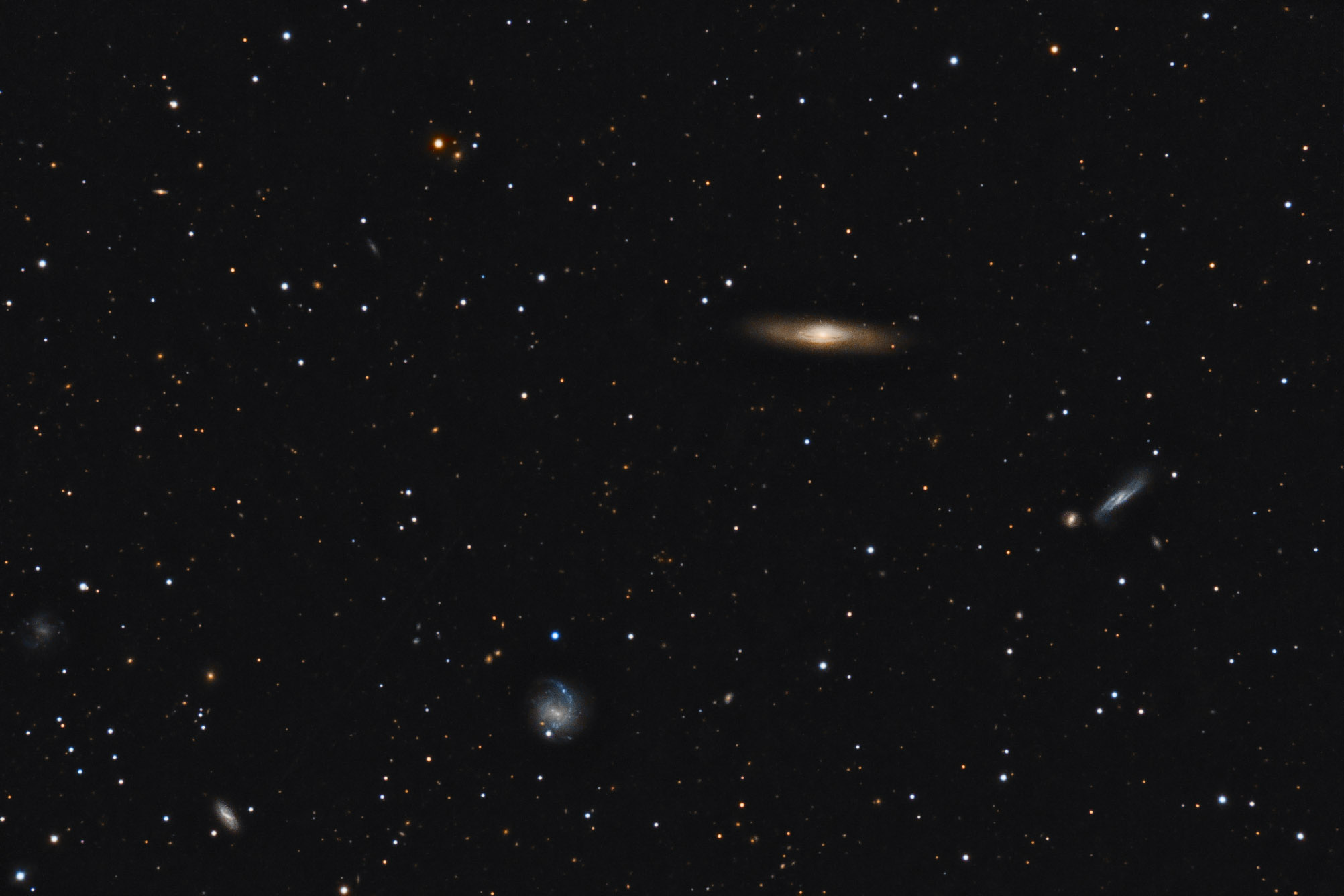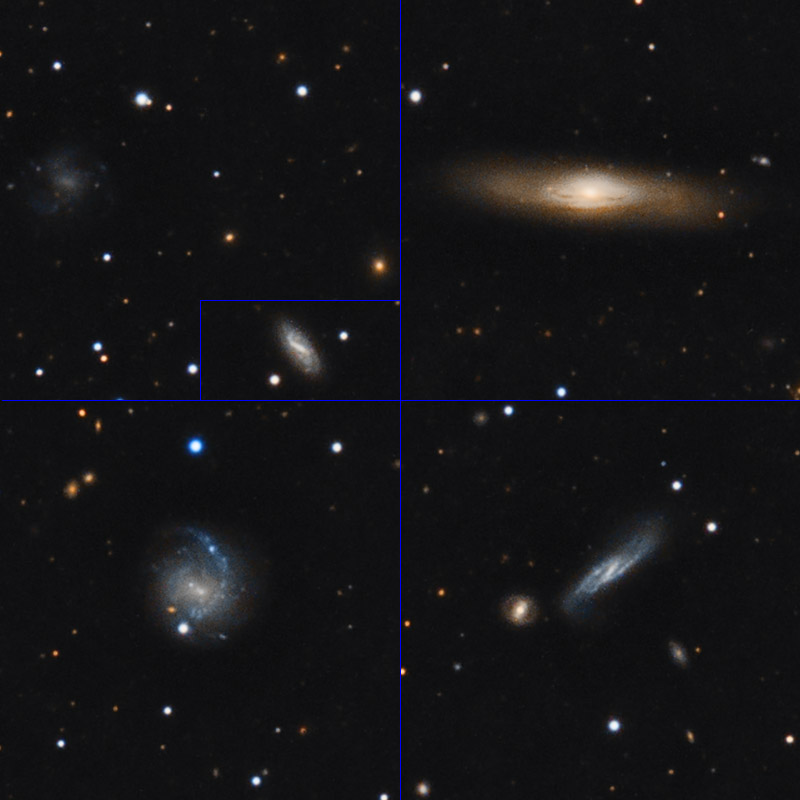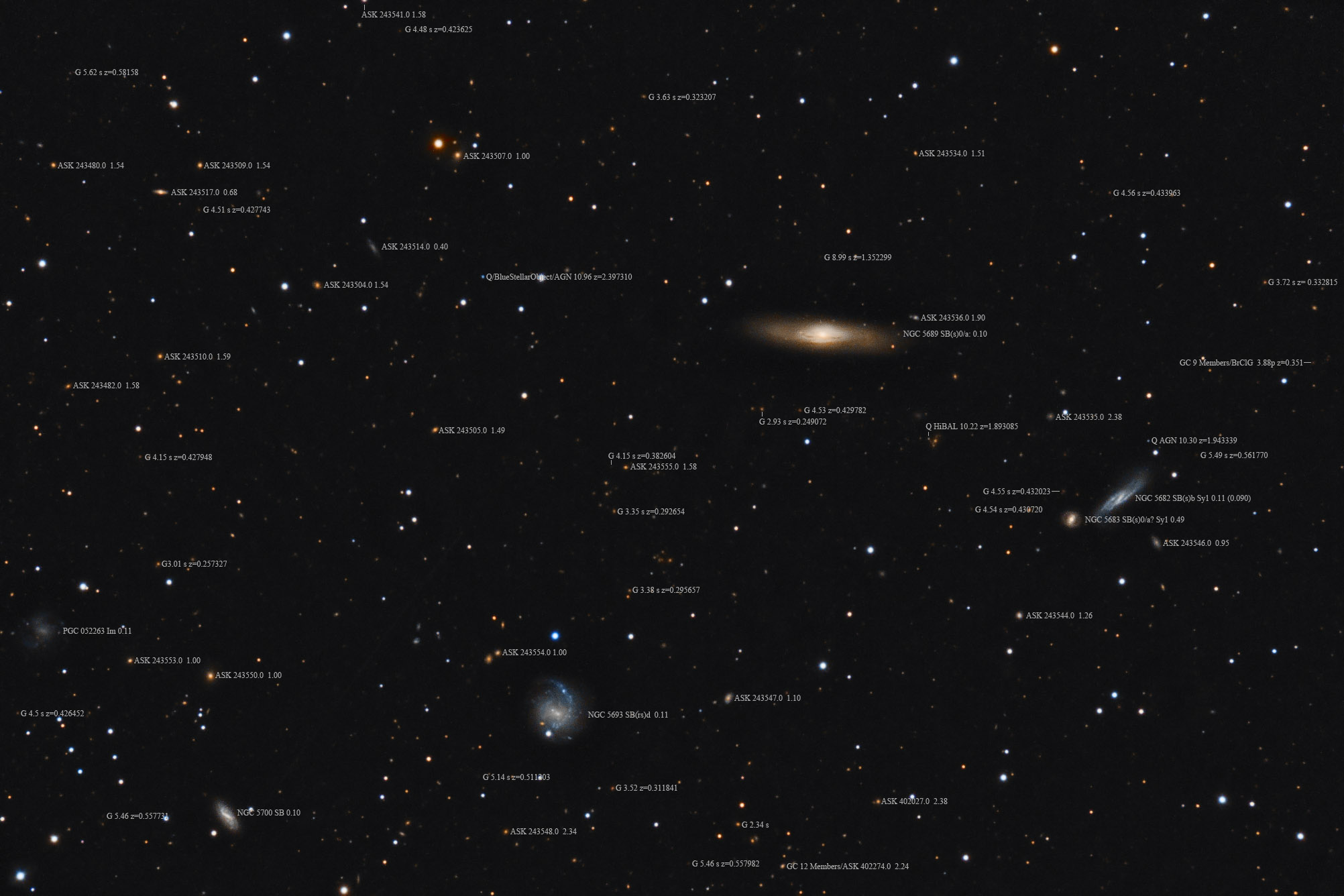| Description | Images |
Object name: NGC5689Designation(s): NGC5689, NGC5682, NGC5683, NGC5693, NGC5700, This field of 5 NGC galaxies is located in northern Bootes. 4 are part of the NGC 5689 group at about 110 million light years. The fifth is about half the distance. The four at about the same distance are; NGC 5682 discovered by George Stoney on April 13, 1850, NGC 5689 for which the group is sometimes named was discovered by William Herschel on May 12, 1787, NGC 5693 also discovered by George Stoney on April 13, 1850 and NGC 5700 discovered by Lawrence Parsons. While his employees discovered many of the galaxies some attribute to him this one he likely really did discover. The 5th member NGC 5683 that's much closer was also found by George Stoney on April 13, 1850. George Stoney was one of Lawrence Parsons' astronomers. Related Designation(s):1RXP J143452.1+483933, 1RXS J143452.3+483938, 1WGA J1434.8+4839, 2MASS J14344486+4840142, 2MASS J14344498+4840133, 2MASS J14345246+4839426, 2MASS J14352972+4844297, 2MASS J14370157+4832417, 2MASS J14370168+4832424, 2MASX J14344551+4840039, 2MASX J14345248+4839429, 2MASX J14352967+4844293, 2MASX J14361115+4835043, 2MASX J14370164+4832422, 2PBC J1434.9+4839, 2XMM J143452.4+483943, 2XMM J143529.6+484430, 2XMMp J143452.4+483942, 2XMMp J143529.6+484430, ASK 243542.0, ASK 243545.0, ASK 243549.0, CALIFA 758, CG 0476, CGCG 1433.0+4853, CGCG 1433.1+4852, CGCG 1433.7+4857, CGCG 1434.4+4847, CGCG 1435.3+4845, CGCG 248-008, CGCG 248-009, CGCG 248-010, CGCG 248-011, CGCG 248-013, GALEXASC J143452.51+483942.7 , GALEXASC J143529.67+484431.4 , GALEXASC J143701.72+483241.7 , GALEXMSC J143452.50+483942.7 , GALEXMSC J143529.50+484430.5 , GALEXMSC J143701.69+483241.5 , HDCE 0877 NED004, HOLM 663A, HOLM 663B, IRAS 14329+4853, IRAS 14337+4857, IRAS F14329+4853, IRAS F14337+4857, IRAS F14344+4848, IRAS F14352+4845, ISOSS J14354+4844, KUG 1432+488, KUG 1433+488, KUG 1434+488, KUG 1435+487, LDCE 1043 NED015, LGG 384:[G93] 006, LGG 384:[G93] 007, LGG 384:[G93] 008, LQAC 218+048 010, MAPS-NGP O_176_0067618, MCG +08-27-002, MCG +08-27-003, MCG +08-27-004, MCG +08-27-006, MCG +08-27-007, MRK 0474, NGC 5682, NGC 5683, NGC 5689, NGC 5693, NGC 5700, NGC5682, NGC5683, NGC5689, NGC5693, NGC5700, NPM1G +48.0275, NSA 043186, NSA 043187, NSA 043188, NSA 043189, NSA 145314, PBC J1434.9+4839, PGC 052107, PGC 052114, PGC 052154, PGC 052194, PGC 052237, RBS 1407, RX J1434.8+4839, RX J1434.8+4839:[BEV98] 001, RX J1434.8+4839:[ZEH2003] 01 , SDSS J143444.94+484013.1, SDSS J143444.97+484012.8, SDSS J143444.98+484012.9, SDSS J143452.45+483942.7, SDSS J143452.45+483942.8, SDSS J143452.46+483942.7, SDSS J143611.18+483506.1, SDSS J143611.19+483506.1, SDSS J143611.19+483506.2, SDSS J143701.54+483241.4, SDSS J143701.56+483241.3, SDSS J143701.56+483241.4, SDSS J143701.57+483241.4, SSTSL2 J143452.48+483942.7, SSTSL2 J143529.75+484430.1, UGC 09388, UGC 09399, UGC 09406, UGC 09423, UNAM-KIAS 1220, USGC U642 NED01, USGC U642 NED02, USGC U642 NED03, USGC U642 NED04, USGC U642 NED05, UZC J143445.1+484012, UZC J143452.5+483941, UZC J143529.7+484430, UZC J143611.4+483507, UZC J143701.7+483242, UZC-CG 224 NED01, UZC-CG 224 NED02, UZC-CG 224 NED03, UZC-CG 224 NED04, WARP J1435.4+4845, WBL 516-001, WBL 516-002, WBL 516-003, [A96] J143452.3+483945.5, [dML87] 687, [GL2009] 63, [GMW2009] 54, [M98j] 231 NED05, [M98j] 231 NED06, [OYS2015] J218.71857+48.66188 , [SHV2006] 0600, [SLK2004] 1029, [VCV2001] J143452.4+483943, [VCV2006] J143452.4+483943, | Permanent link: https://images.mantrapskies.com/catalog/NGC/NGC5689-NGC5682-NGC5683-NGC5693-NGC5700/NGC5689L4X10RG2X10.JPG |


